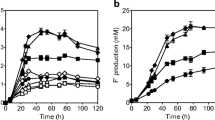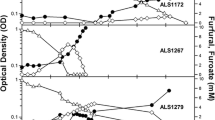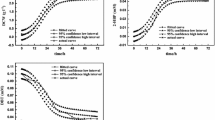Summary
A survey was conducted with seventeen enteric bacterial strains (including the generaKlebsiella, Enterobacter, Escherichia, Citrobacter, Edwardsiella andProteus) to examine their ability to transform furfural and 5-hydroxymethyl furfural (5-MHF). The enteric bacteria were able to convert furfural to furfuryl alcohol under both aerobic and anaerobic conditions in a relatively short incubation time of 8 h. 5-HMF was transformed by all the enteric bacteria studied to an unidentified compound postulated to be 5-hydroxymethyl furfuryl alcohol, which had an absorbance maximum of 222 nm. These bacteria did not transform furfuryl alcohol or 2-furoic acid. The enteric bacteria did not use furfural, 5-HMF, furfuryl alcohol or 2-furoic acid as sole source of carbon and energy. Biotransformation of furfural and 5-HMF was accomplished by co-metabolism in the presence of glucose and peptone as main substrates. The rate of transformation was similar under both aerobic and anaerobic conditions. These transformations are likely to be of value in the detoxification of furfurals, and in their ultimate conversion to methane and CO2 by anaerobic digestion.
Similar content being viewed by others
References
Abdulrashid, N. and D. Clark. 1987. Isolation and genetic analysis of mutants allowing the degradation of furans and thiophenes byE. coli. J. Bacteriol. 169: 1267–1271.
Azhar, A.F., M.K. Berk, A.R. Colcord, R.S. Roberts and G.V. Corbitt. 1981. Factors affecting alcohol fermentation of wood acid hydrolysate. Biotechnol. Bioeng. Symp. 11: 293–300.
Balch, W.E. and R.S. Wolfe. 1976. New approach to the cultivation of methanogenic bacteria: 2-mercaptoethane sulfonic acid (HS-CoM) dependent growth ofMethanobacterium ruminantium in a pressurized atmosphere. Appl. Environ. Microbiol. 32: 781–791.
Benjamin, M.M., S.L. Woods and J.F. Ferguson. 1984. Anaerobic toxicity and biodegradability of the pulp mill waste constituents. Water Res. 18: 601–607.
Brune, G., S.M. Schoberth and H. Sahm. 1982. Anaerobic treatment of an industrial wastewater containing acetic acid, furfural and sulphite. Process. Biochem. 17: 20–35.
Brune, G., S.M. Schoberth and H. Sahm. 1983. Growth of a strictly anaerobic bacterium on furfural (2-furaldehyde). Appl. Environ. Microbiol. 46: 1187–1192.
Boopathy, R. and L. Daniels. 1991. Isolation and characterization of a furfural degrading sulfate reducing bacterium isolated from an anaerobic digester. Curr. Microbiol. 23: 327–332.
Dean, F.M. 1963. Naturally Occurring Ring Compounds. Butterworths, London, pp. 1–15.
Folkerts, M., U. Ney, H. Kneifel, E. Stackebrandt, E.G. Witte, H. Forstel, S.M. Schoberth and H. Sahm. 1989.Desulfovibrio furfuralis sp. nov., a furfural degrading strictly anaerobic bacterium. Syst. Appl. Microbiol. 11: 161–169.
Harris, W.L., R.A. Wirtz, S. Sung and R.R. Dague. 1991. Anaerobic Filter Treatment of Furfural Byproduct Wastewater. Proceedings of the 46th Industrial Waste Conference, West Lafayette, IN.
Hong, S.W., H.E. Han and K.S. Chae. 1981. Detection of furfural and 2-furoic acid in bacterial cultures by HPLC. J. Liquid Chromatogr. 4: 285–291.
Kieslich, K. 1976. Microbial Transformation of Nonsteroid Cyclic Compounds. Thieme Verlag, Stuttgart.
Koenig, K. and J.R. Andreesen. 1989. Molybdenum involvement in aerobic degradation of 2-furoic acid byPseudomonas putida Fu-1. Appl. Environ. Microbiol. 55: 1829–1834.
McCarty, P.L., L.Y. Young, D.C. Stuckey and B.B. Healy Jr. 1977. Heat treatment for increasing methane yields from organic materials. In: Microbial Energy Conversion (Schlegel, H.G. and Barnea J. eds.), pp. 179–199, Pergamon Press, Oxford.
Monnier, V. 1990. Nonenzymatic glycosylation, the Maillard reaction and the aging process. J. Gerontol. 45: B105-B111.
Morris, J.A., A. Kheltry and E.W. Seitz. 1978. Antimicrobial activity of aroma chemicals and essential oils. J. Am. Oil. Chem. Soc. 56: 595–603.
Soboleva, G.A., V.I. Golubkov and A.M. Vitrinskaya. 1983. Effect of furfural on the cytochrome system of yeasts. Mikrobiologiya 42: 441–444.
Trudgill, P.W. 1984. The microbial metabolism of furans. In: Microbial Degradation of Organic Compounds. (Gibson, D.T. (ed.)) pp. 295–307, Marcel Dekker, New York.
Windholz, M., M. Budvari, L.Y. Stroumtsos and M.N. Fertig. 1976. The Merck Index, 9th edn. Merck and Co., Raway, NJ.
Author information
Authors and Affiliations
Rights and permissions
About this article
Cite this article
Boopathy, R., Bokang, H. & Daniels, L. Biotransformation of furfural and 5-hydroxymethyl furfural by enteric bacteria. Journal of Industrial Microbiology 11, 147–150 (1993). https://doi.org/10.1007/BF01583715
Received:
Revised:
Accepted:
Issue Date:
DOI: https://doi.org/10.1007/BF01583715




